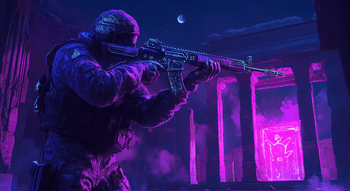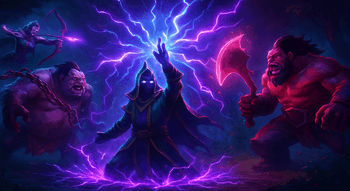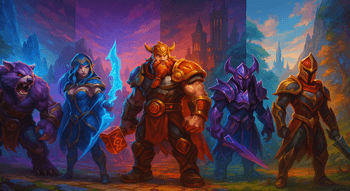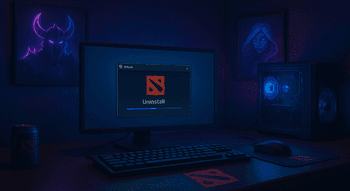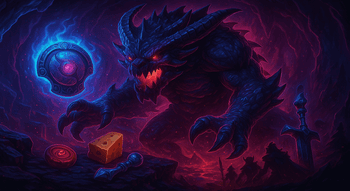How to Fix Lag in Dota 2
Contents
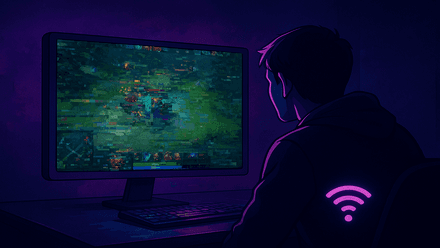
This article is a comprehensive guide on Dota 2 lagging. From freezes and FPS drops to disconnects, we will walk you through every common issue reported by users, help you pinpoint the causes, and suggest practical fixes. We will also go through some of the advanced solutions for those whose problems don’t fall into general patterns. Jump in!
Common Causes of Lag in Dota 2
Although Dota 2 is relatively a lightweight game by modern standards, even users with the best hardware experience lags time after time. In this section, we will discuss the common causes of this issue.
Network Issues
Wondering, "Why is my Dota 2 lagging?" The first thing you should check is your network connection. To do this, while in a game, open chat and type “-ping.” Your ping will appear in the top-right corner for a few seconds. A ping above ~100 usually means network lag.

However, connection issues aren’t limited to high ping. Even with a stable ping, players may experience lag caused by packet loss, which indicating an unstable connection. If your game freezes, units “teleport,” and your inputs occasionally go unregistered (e.g., you press a key and the game acts as if nothing happened), packet loss is likely the cause. You can check the value by using the same “-ping” command — if the packet loss value is higher than 0, you’re dealing with a connection problem.
If packet loss is the culprit, you may want to read our how to fix Dota 2 packet loss guide for practical solutions.
Hardware Limitations
If you notice Dota 2 lagging with good internet, your hardware might be to blame. While the game can be considered relatively lightweight, some people still have weak setups that can’t handle it. Below are the system requirements to run the game on Windows:

Keep in mind that these are minimum requirements. If you raise your graphic settings even slightly above low, you may encounter frame rate drops or stuttering.
Background Applications
As with any other demanding software, Dota 2 lag can be caused by applications running in the background. Whether it's Discord, some kinds of overlays, web browsers, or torrent clients, they consume your CPU, GPU, and RAM. Therefore, to ensure smooth gameplay, close everything that isn’t essential before launching Dota 2.
Game File & Client Issues
Dota 2 lagging in the game is very common for some time after updates or new patches. This is caused by the introduction of new content (maps, models, mechanics, etc.) Besides the obvious things, such as improved graphics requiring more resources from your hardware, new additions can conflict with outdated drivers, or be poorly optimized right after the release. On the bright side, Valve usually patches performance issues relatively quickly, so they tend to be short-lived.
How to Diagnose Lag Problems
To begin with, lag is never truly random — there’s always a cause. Start with the basics by checking your hardware. Thus, even if you meet the minimum requirements, which includes a dual-core CPU at 2.8 GHz, 4 GB of RAM, and a minimum of 256 MB of graphics card memory, intensive 5v5 fights can still cause lag. To ensure your hardware is up to par, you should have a quad-core CPU at 2.8 GHz, at least 8 GB of RAM, and a 4 GB graphic card.
Once hardware is ruled out, it's time to utilize some built-in Dota 2 tools to identify the source of your lags and freezes:
- Launch the game and go to Settings.
- In the search field, type
networkand enable “Display Network Information.”
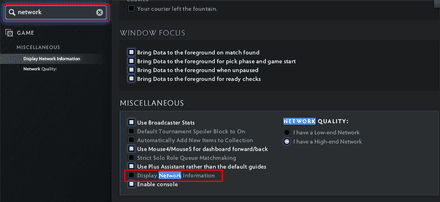
- This will display your ping and packet loss in the top right corner during matches.

- Also, for more detailed diagnostics, open the console (the default key in Dota 2 is “\”) and type
net_status. Make sure Developer Console is enabled in your settings under the same “Miscellaneous” tab.

If the network stats are fine, but the game still lags, then it’s most likely a hardware or system-related issue.
Basic Fixes to Reduce Lag in Dota 2
Let’s move on to actionable steps you can take to reduce or eliminate lag in Dota 2. Whether network or hardware/system-related, these steps will resolve most issues.
Lowering In-Game Graphics Settings
To check what rendering settings you have and adjust them, go to Dota 2 Settings and select the Video tab in the menu on the left. From there, scroll down to Rendering or just click it in the same menu on the left. Select “Use advanced settings” and uncheck unnecessary “fluff.” Here’s a basic example of Rendering settings that that strike a good balance between making the game smooth and still visually appealing:
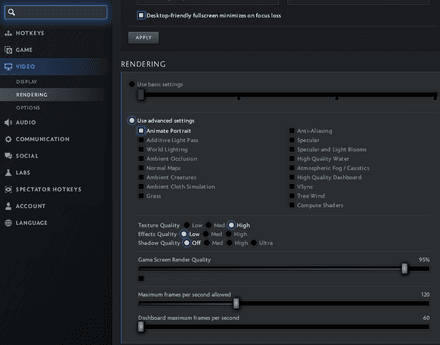
If this feels like too much of a downgrade for you, try toggling individual options on and off to see how they impact performance changes — this experimentation can help you find the best compromise for your system.
For a more detailed breakdown of graphical tweaks, check out our best Dota 2 settings for FPS boost guide.
Closing Unnecessary Background Apps
Before launching Dota 2, make sure to close all non-essential programs, especially anything that uses bandwidth or system resources. This includes apps like Discord, Telegram, cloud sync tools, update managers, or background browser tabs. These processes fill up bandwidth and cause spikes in ping, even if they aren’t visibly active.
Check your system tray (bottom right corner of your screen on Windows) and Task Manager, and end any unnecessary background processes to ensure your network is fully dedicated to Dota 2.

Updating Drivers
Sometimes, lag in Dota 2 happens just because your drivers are old and haven’t been updated in a while. This is especially true for the graphics card and network adapter drivers.
Visit the NVIDIA or AMD website (depending on your GPU), enter your graphics card series, and download the latest driver. For the network hardware, check your PC or laptop motherboard manufacturer’s support page and download the latest drivers from there. You can also use third-party driver managers like Driver Booster to automate the process using a simple GUI, though manual installation/update is usually more reliable and recommended for gamers.
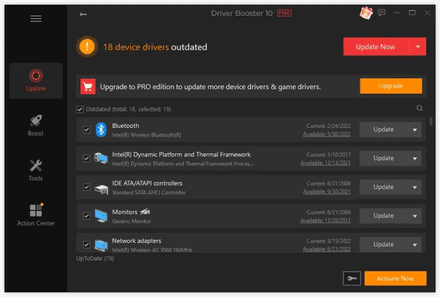
Setting Dota 2 Server Regions
Choosing the right matchmaking server is essential to keeping your ping low. Here's how:
- Click “Play Dota” in the bottom right corner of the main menu and click on Region.

In the opened window, check one or multiple servers with the lowest ping shown next to them, and click OK to save your changes.
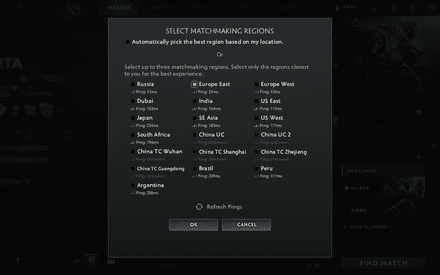
Using Ethernet Connection Instead of Wireless
The type of connection plays a major role in lag. Wi-Fi, while convenient, is often unreliable for online games, especially in the MOBA genre, where every second counts. Besides, your router may also suffer from bufferbloat (sudden spikes in latency), which can severely impact gameplay. To avoid such issues, we strongly recommend using a wired Ethernet connection. It provides a more stable and consistent experience, eliminating many of the random lag spikes and disconnections that Wi-Fi can cause.
Verifying the integrity of Game Files
Sometimes, Dota 2 is lagging due to corrupted or missing game files. Here’s how to verify and fix them:
- Open Steam and go to the Library tab.

- Find Dota 2, right-click it, and select Properties.

- In the left-hand menu, select the Installed Files tab.
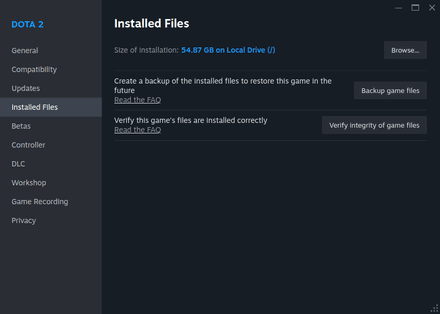
- Click on Verify integrity of game files (the last option).

- Wait for the process to complete — it usually takes about 5 minutes. Avoid doing this while in a game, as it might cause interruptions.

Advanced Troubleshooting Methods
In certain cases, basic fixes just aren’t enough. Let’s look at some more advanced methods to eliminate lag in Dota 2.
Adjusting Network Settings
Sometimes, poor routes to Valve’s servers (e.g., via GSL networks) can cause persistent packet loss and latency spikes, fixable only through changing your internet provider. It’s a significant step, so we recommend trying to disable IPv6 in your router's settings first. Many users report reduced stuttering after doing this.
One more thing that might actually work is to enable the in-game “Low-end Network” option from the in-game settings. This setting helps stabilize your connection under poor network connection conditions.

You can further improve performance by applying our best Dota 2 launch options for FPS recommendations.
Using VPN
If you’ve already tried the usual fixes and are still wondering how to fix lag in Dota 2, it might be worth considering using a VPN. Sometimes, your internet provider sends your game data over an unusual route, which can cause your ping to fluctuate or result in random freezes. A reliable VPN can help by picking a faster or more stable path to the game servers. This is especially true for those who are playing on “faraway” servers. However, avoid using random free VPNs, as they tend to cause even more delay and instability.
Conclusion
That’s it for our guide on how to fix lagging in Dota 2. Although Dota 2 lag fix can be challenging, this checklist should help you get back on the right track and enjoy smoother gameplay. If you still have questions or need help troubleshooting a specific issue, feel free to leave a comment — we’re here to support you. Good luck and have fun!
